Female ski jumpers are taking their place on the hill
Though ski jumping’s first female competitors are considered pioneers in the sport, their first goal is simple: Go farther.
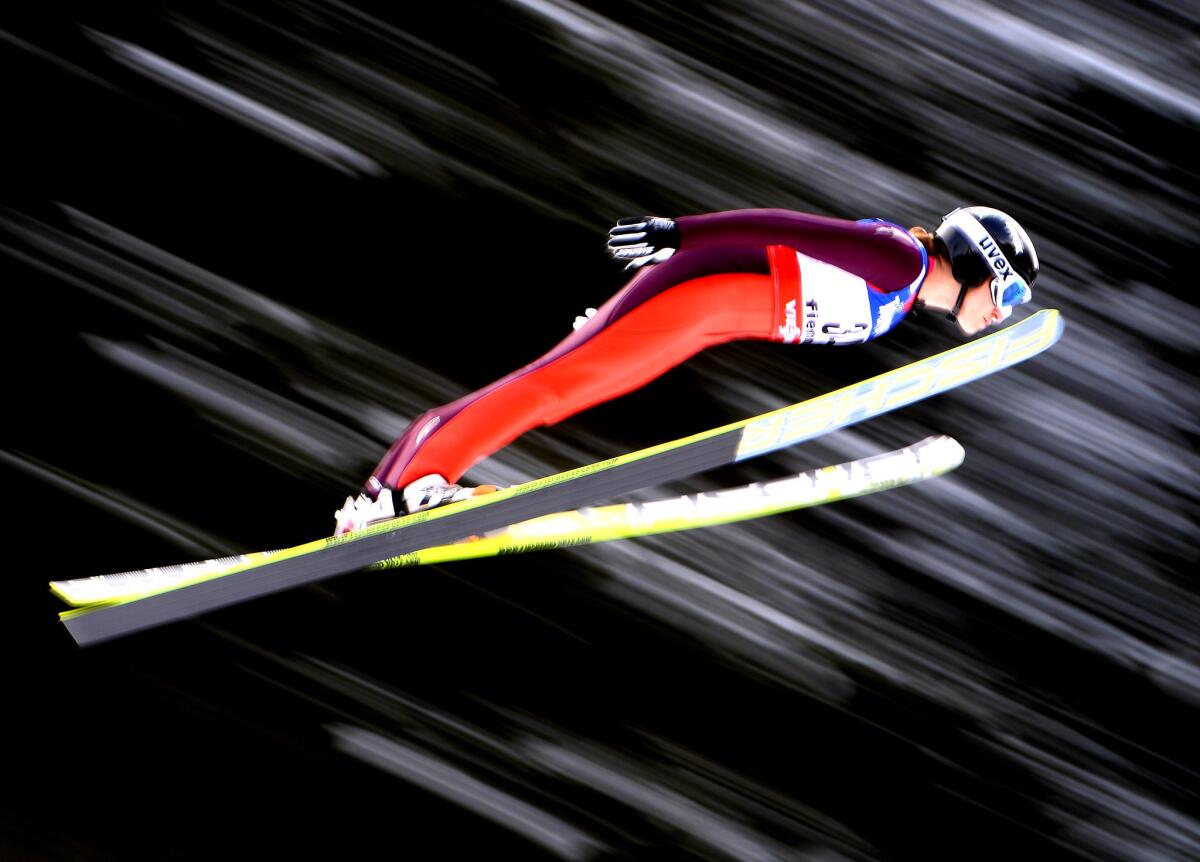
The start house isn't much of a house, more like a concrete box perched high on the mountain.
Five women arrive on this frosty morning, setting their skis down outside and pushing through the door, rubbing their hands in the cold. They take turns leaning close to a heater, asking: "Is this thing working?"
Their complaints soon give way to chatter, as if the room might be warmed by voices echoing off bare walls, by talk of grocery shopping and friends and the contents of a thermos someone brought.
"Is it really hot cider?"
The start house has been their second home since they were girls, a place where these misfits could feel accepted. Even now, as adults, they consider it a haven.
Lindsey Van, the oldest one, explains: "There's no way you could do this by yourself."
They tug at the laces on their stiff leather boots and tighten the straps on their helmets. Just outside, a few paces away, waits an Olympic-sized ski jump.
Women were traditionally discouraged from clicking on skis and flying off the end of a steep ramp. Sports officials considered it too dangerous for them.
The women who train in Park City — members of the U.S. national team — have spent a decade fighting that notion. Next month, they will join competitors from around the world as female jumpers make their Olympic debut at the 2014 Sochi Games.
"People call you a pioneer or a barrier breaker," Van says. "But that's not what you're thinking about when you're doing it."

A thick metal bar runs across the top of the jump, about knee-high. Jessica Jerome slides across it, finding just the right spot to sit.
If Van tends to be reticent, Jerome is her opposite with a quick wit and sharp tongue. But this is no time for talking. After a moment's pause to collect her thoughts, she gently rocks and pushes off.
With her skis fixed into grooves down the sheer in-run, speed comes almost instantly. A balanced crouch works best but is difficult to maintain against strong G-forces.
The team's coach, Alan Alborn, watches from a nearby platform.
"When you're cruising down that thing at 60 miles an hour, the brain is saying, 'This isn't safe. I shouldn't be doing this,'" he says. "You have to fight through that."
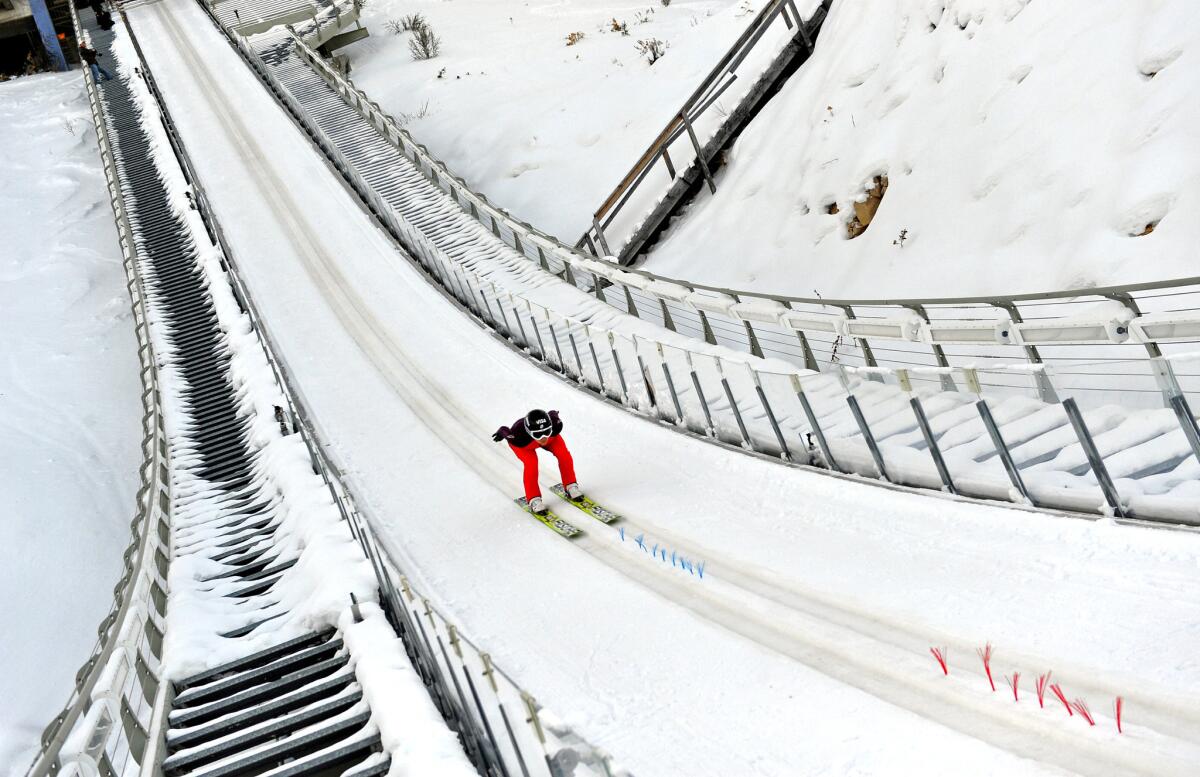
Jessica Jerome skis down the jump chute at a team training event at Utah Olympic Park on Dec. 26. Jerome recently secured a spot at the 2014 Sochi Games by winning the American team trials. (Gene Sweeney Jr. / Getty Images) More photos
The track levels off at the very end, giving Jerome only a tenth of a second to spring up and jump. With skis rattling and a whoosh of air, she sounds like a small plane at liftoff.
Her body becomes a type of wing as she leans over her ski tips and sails through the air, feeling the wind's pressure against her skintight suit. Her arms angle back.
"I'm trying to look farther than I want to go," she says. "We call it 'pulling.'"
And one more thing: "If it's really far, I'm thinking about how much my knees are going to hurt when I land."
Television makes it look like jumpers shoot upward. In fact, they follow the slope of the hill, remaining 10 to 15 feet above ground in a controlled descent where even the slightest technical lapse can cost distance.
Roughly six seconds pass from the top to the landing area below where Jerome's skis clap down on groomed snow. Six seconds of fear, adrenaline and pure thrill.
Jerome calls it an indescribable sensation. Another team member, the teenage Sarah Hendrickson, remembers being hooked from the start.
"Not many people can say they fly a football field and a half in the air with skis on," she says. "Occasionally I catch myself thinking about how crazy this is."
Injuries are common. Hendrickson is recovering from knee surgery and the others have endured a litany of ailments, including torn ligaments, broken bones and a ruptured spleen.
"When you're injured, you miss the feeling," Van says of jumping. "You crave it."

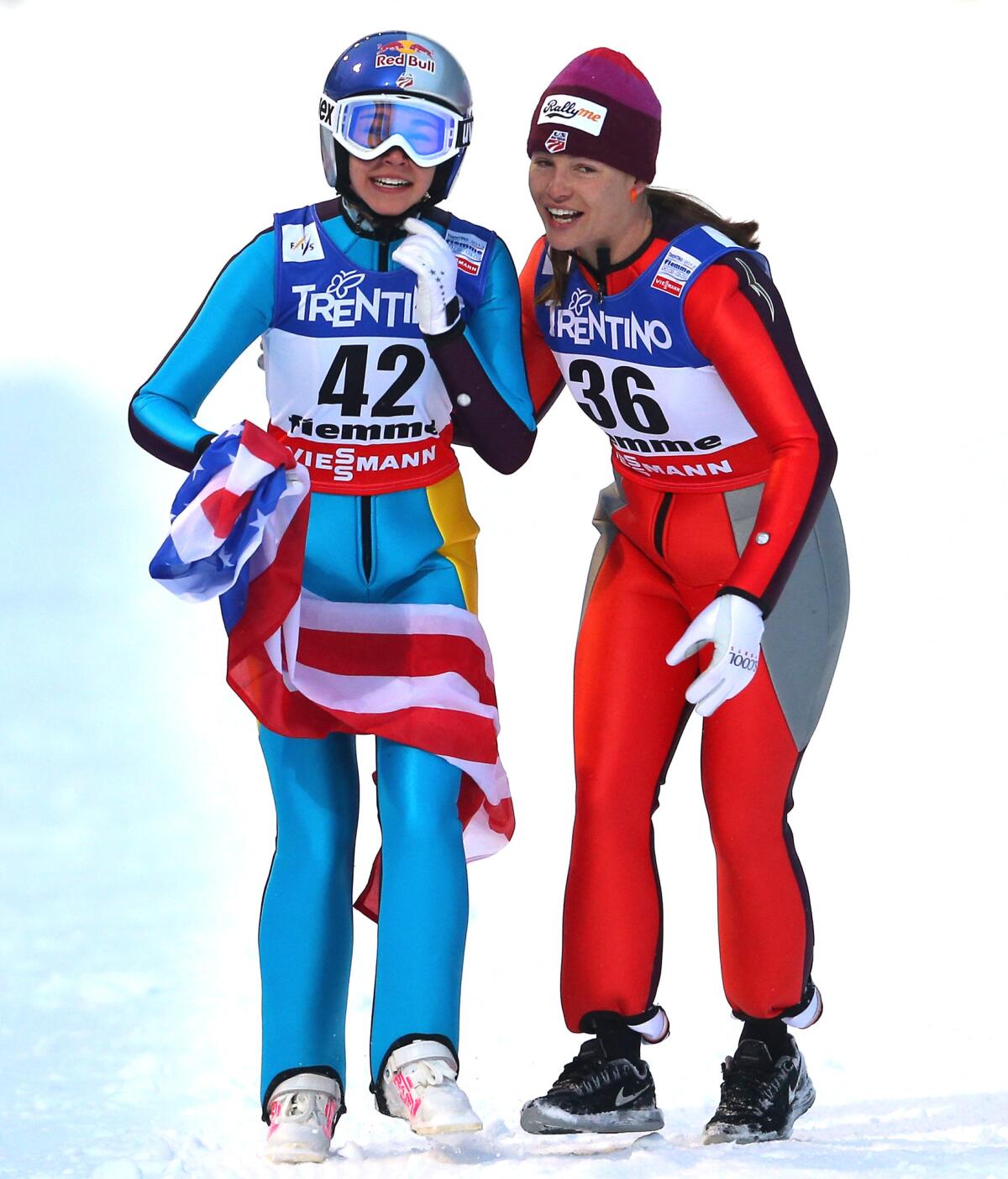
After winning an event at the FIS Nordic World Ski Championships in Italy last February, U.S. competitor Sarah Hendrickson, left, ceberates with teammate Lindsey Van. (Alexander Hassenstein / Getty Images) More photos
Some had older brothers who jumped. Others got drawn into the sport by an after-school program in this resort town east of Salt Lake City.
Of the five core members on the national team, Van started jumping first; built short and powerful, she was one of only a few girls on the hill in the early 1990s. Next came Jerome and the other veterans, Abby Hughes and Alissa Johnson.
By the time Hendrickson showed up around 2002 with an ultra-slim physique that would become the sport's standard, she could look to the older girls as role models.
"I would watch them jump," she recalls.
They all grew up within minutes of each other, fortunate to live near a world-class venue that was built for the 2002 Salt Lake City Olympics. But any advantage ended there.
Since its Nordic beginnings in 1808, ski jumping had never truly welcomed women. Van and the others discovered that only men could compete in World Cup events.
In the late 1990s, organizers pieced together a circuit for a small group of women who traveled on shoestring budgets, sharing equipment and cramped rooms on the road.
Though the best women could fly almost as far as their male counterparts, they were relegated to second-rate hills. Sports officials, Jerome says, "would never have asked men to jump at those facilities."
In 2008, female jumpers from five countries filed a discrimination suit against the Canadian organizers of the 2010 Vancouver Olympics, demanding the right to compete. Van, who won the inaugural women's world championship in 2009, became their spokeswoman.
"I want to make this right for future girls," she said.
Shortly thereafter, U.S. ski officials tightened their budget and withdrew funding for the program. And when an appeals court ruled that Canadian organizers had no right to dictate Olympic policy, a tearful Van proclaimed "from here our sport is stagnant, it doesn't go anywhere."

We love each other like sisters. And we fight like sisters."— Jessica Jerome
It could be in a motel in Lillehammer. Or Oberstdorf. Or Lake Placid.
Wherever the teammates are, Van is the one who usually gets up early, stumbling across the darkened room she shares with them.
"I'm sorry, I'm sorry," she will whisper.
"Stop saying you're sorry," Jerome, the night owl, will hiss from her bed. "You're keeping me awake."
The bond among the five — who range in age from 19 to 28 — is forged of joy, frustration and frequent-flier miles. Their family has grown to include newer members such as Nina Lussi. At international competitions, they talk and laugh in the start house, just like at home.
"We enjoy being around each other," Hendrickson says.
Most of the time.
These are elite athletes, and they constantly try to outdo each other on the hill or in the gym, so nerves become frayed.
The group dynamic has been tested by Hendrickson's startling success — last season, at 18, she won nine of 13 World Cup events. Alborn says: "Everybody is jealous of Sarah, which is understandable."
Hendrickson can be demanding and irritable in ways that befit her age, and the coach has called more than one team meeting to air grievances.
"We love each other like sisters," Jerome says. "And we fight like sisters."

The morning follows a routine. Fly. Land. Repeat. Everyone tries to fit five or six jumps into two hours of practice.
Coming off the chairlift, Hughes ducks into the start house and grabs a walkie-talkie to check with Alborn on his platform halfway down the hill.
"I think it still needs to be a little lower," she says, referring to her crouch on the in-run.
"More dynamic," the coach responds. "Use all the available power."
Hughes nods and goes back outside, taking her place in line with the other women and some of the men who train in Park City.

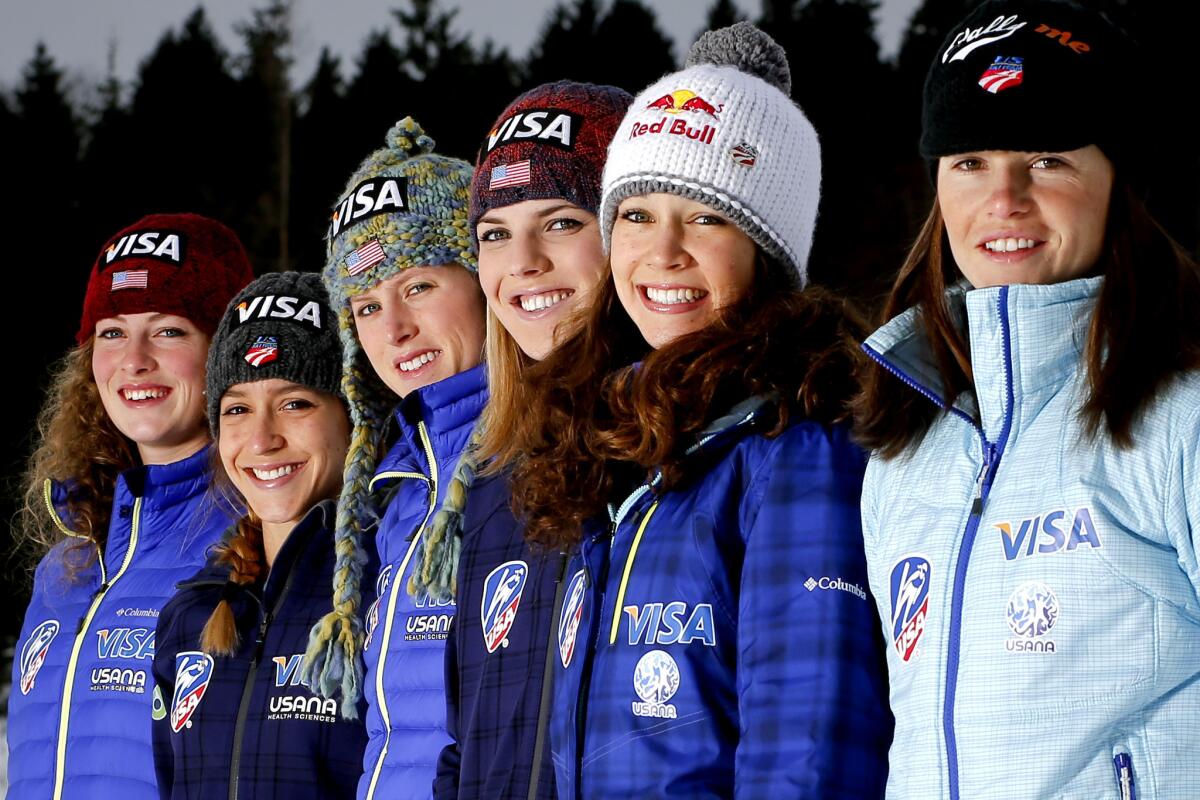
U.S. women's team members Nina Lussi, left, Jessica Jerome, Alissa Johnson, Abby Hughes, Sarah Hendrickson and Lindsey Van pose on Dec. 15, 2012, in Ramsau, Austria. (Stanko Gruden / Getty Images) More photos
Things changed dramatically after the discouraging court decision in Vancouver. The International Ski Federation created a World Cup circuit for female jumpers and then the International Olympic Committee added them to the Games, albeit only for the normal hill.
Men get to compete on the normal and the large, where the in-run is longer. Still, the women are happy.
"It probably took a year before I realized this was happening," Van says. "It's hard to switch your mind from a no to a yes."
With February and the Olympics drawing near, the Americans cannot help feeling excited and nervous and every other emotion that comes with a watershed moment.
As they embark on a new World Cup season, Van is enjoying a resurgence in her career and Hendrickson — who hurt her knee on a training jump in Germany — still hopes to be in Sochi.
There is, however, a dark reality on the horizon. With an expected four spots on the U.S. Olympic squad, not everyone can go.
Last weekend, Jerome secured her place by winning the American team trials in Park City. The remaining spots will be filled later this month.
Alborn, a three-time Olympian in his jumping days, has warned his athletes about the stress of qualifying and the pressure-cooker atmosphere at the Games. He has talked about perseverance.
Van shrugs it off.
"Even though we have the Olympics," she says, "nothing has changed."
No matter who stays or goes, the women of the U.S. team will always have the thrill of jumping. And no matter what happens in Sochi, they can all come back to the start house on frosty mornings.
They still have each other.
Follow David Wharton (@LATimesWharton) on Twitter
Follow @latgreatreads on Twitter
More great reads
At 95, this pianist is still playing Las Vegas' tune
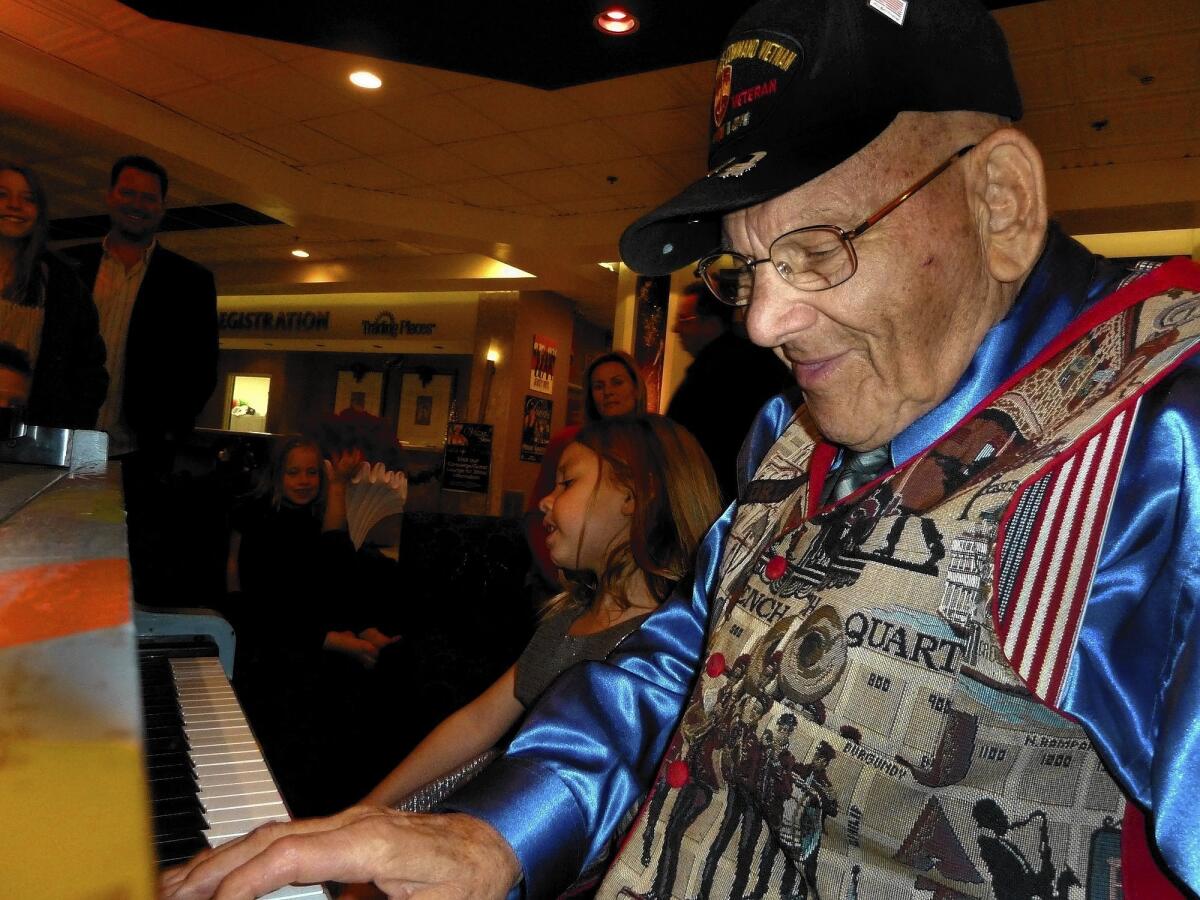
Joe has a tremendous memory and he likes to talk about knowing famous people."
One troubled priest who got a second chance

He told me that he had developed a relationship with one of the boys."
Go beyond the scoreboard
Get the latest on L.A.'s teams in the daily Sports Report newsletter.
You may occasionally receive promotional content from the Los Angeles Times.








